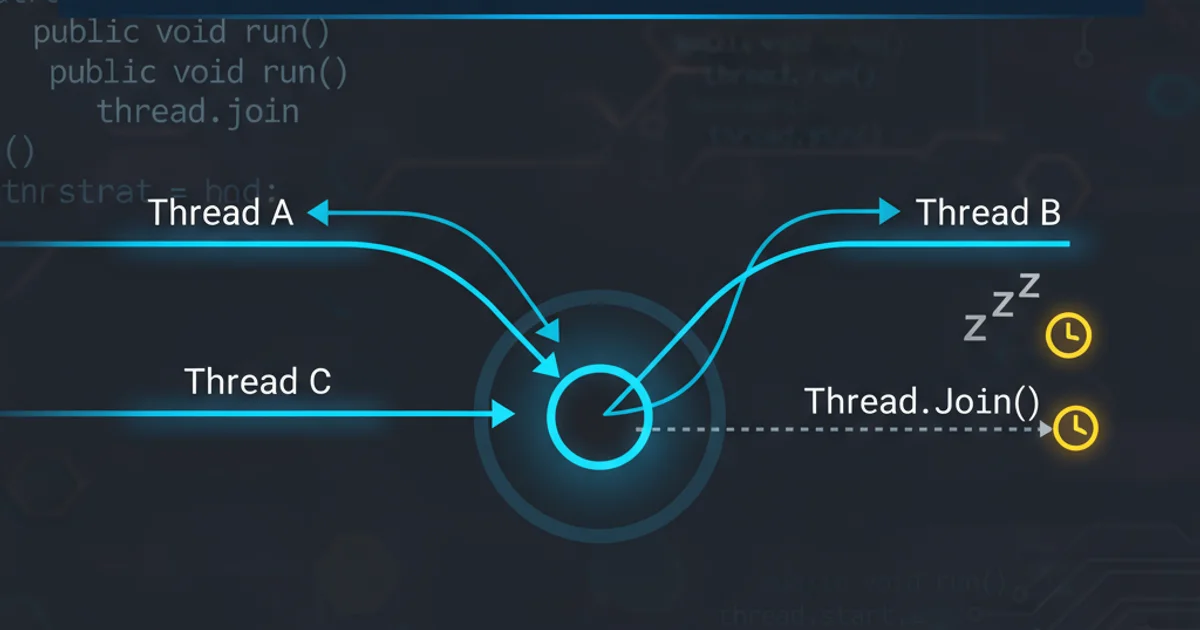Do you need a Sleep before attempting a Thread Join?
Categories:
To Sleep or Not to Sleep: The Thread.Join() Dilemma

Explore whether a Thread.Sleep() is necessary before Thread.Join() in C# to prevent NullReferenceException and understand best practices for thread synchronization.
When working with multithreading in C#, Thread.Join() is a fundamental method used to ensure that a calling thread waits for another thread to complete its execution. A common question that arises, especially for developers new to concurrent programming, is whether a Thread.Sleep() call is required immediately before Thread.Join() to prevent issues like NullReferenceException. This article will demystify this concept, explain the mechanics of Thread.Join(), and provide best practices for robust thread synchronization.
Understanding Thread.Join()
The Thread.Join() method is designed to block the calling thread until the thread on which Join() is called has terminated. This termination can occur naturally (the thread's work is done), or due to an unhandled exception. The primary purpose of Join() is to synchronize the completion of threads, ensuring that resources used by a child thread are not accessed or disposed of prematurely by the parent thread, or that results from a child thread are available before further processing.
flowchart TD
A[Main Thread Starts] --> B{Create Worker Thread};
B --> C[Worker Thread Executes Task];
C --> D{Worker Thread Completes?};
D -- Yes --> E[Main Thread Calls Join()];
D -- No --> C;
E --> F[Main Thread Resumes];
F --> G[End];Basic flow of Thread.Join() synchronization
Consider a scenario where a main thread starts a worker thread to perform a long-running calculation. The main thread might need the result of this calculation before it can proceed. By calling workerThread.Join(), the main thread will pause its execution until workerThread has finished its job. Without Join(), the main thread would continue immediately, potentially attempting to access an incomplete result or a resource still in use by the worker thread.
The Myth of Thread.Sleep() Before Join()
The short answer is: No, you do not need Thread.Sleep() before Thread.Join(). The Thread.Join() method inherently handles the waiting mechanism. Its sole purpose is to block until the target thread terminates. Introducing Thread.Sleep() before Join() is not only unnecessary but can also be detrimental to your application's performance and responsiveness.
A common misconception might stem from scenarios where developers observe a NullReferenceException and incorrectly attribute it to the lack of a Sleep() call. A NullReferenceException when dealing with threads is almost always indicative of a different underlying issue, such as:
- Accessing a shared resource without proper synchronization: If multiple threads access the same object or data structure without locks or other synchronization primitives, one thread might nullify a reference while another is trying to use it.
- Incorrect thread lifecycle management: A thread might be prematurely terminated or not properly initialized, leading to null references when its state is later queried.
- Race conditions: A race condition occurs when the outcome of a program depends on the sequence or timing of uncontrollable events. If a thread attempts to access an object that another thread is responsible for initializing, and the accessing thread wins the 'race', it might encounter a null reference.
using System;
using System.Threading;
public class ThreadJoinExample
{
private static object _sharedData = null;
public static void Main(string[] args)
{
Console.WriteLine("Main thread: Starting worker thread.");
Thread workerThread = new Thread(DoWork);
workerThread.Start();
// NO Thread.Sleep() needed here.
// The Join() method will correctly wait for the workerThread to finish.
workerThread.Join();
Console.WriteLine("Main thread: Worker thread finished. Accessing shared data.");
// If _sharedData was not initialized in DoWork, this would be a NullReferenceException
// But Join() ensures DoWork completes before we reach here.
Console.WriteLine($"Shared data: {_sharedData}");
Console.WriteLine("Main thread: Exiting.");
}
private static void DoWork()
{
Console.WriteLine("Worker thread: Starting work...");
Thread.Sleep(2000); // Simulate some work
_sharedData = "Data from worker thread"; // Initialize shared data
Console.WriteLine("Worker thread: Work finished.");
}
}
Correct usage of Thread.Join() without Thread.Sleep().
NullReferenceException in multithreaded code, focus on proper synchronization (locks, semaphores, Monitor.Enter/Exit) and careful management of shared resources, rather than adding arbitrary Thread.Sleep() calls.When is Thread.Sleep() Appropriate?
Thread.Sleep() has its place, but it's generally for different purposes than synchronization with Thread.Join():
- Simulating work or delays: As seen in the example,
Thread.Sleep()can be used to simulate a long-running operation for testing or demonstration purposes. - Throttling: In some producer-consumer scenarios, a producer might
Sleep()to avoid overwhelming a consumer or a resource. - Polling with back-off: When polling for a condition,
Sleep()can introduce delays between checks to reduce CPU usage.
However, using Thread.Sleep() for synchronization is often a sign of a design flaw. It introduces non-determinism and can lead to subtle bugs, as the duration of the sleep might not be sufficient on a busy system or too long on a lightly loaded one.
Thread.Sleep() as a substitute for proper synchronization primitives. It makes your code less reliable, harder to debug, and can introduce performance bottlenecks.In conclusion, Thread.Join() is a robust and efficient mechanism for thread synchronization, designed to wait for thread completion without any preceding Thread.Sleep() calls. Understanding its purpose and avoiding common pitfalls will lead to more stable and performant multithreaded applications.